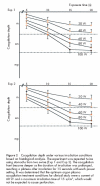Argon plasma coagulation for successful treatment of early gastric cancer with intramucosal invasion
- PMID: 12584212
- PMCID: PMC1773547
- DOI: 10.1136/gut.52.3.334
Argon plasma coagulation for successful treatment of early gastric cancer with intramucosal invasion
Abstract
Background: In recent years, there has been an increasing number of cases of early gastric cancer (T1, NX) with intramucosal invasion, which are untreatable by surgical or endoscopic mucosal resection (EMR) because of their high risk. Currently, no adequate treatment is available for such patients.
Aim: The main objective of this study was to evaluate whether argon plasma coagulation (APC) is an effective and safe modality for treating early gastric cancer untreatable by surgical resection or EMR.
Methods: The study group comprised 20 men and seven women diagnosed with gastric cancer with intramucosal invasion who were considered poor candidates for surgical resection or EMR due to risk factors such as severe cardiac failure or thrombocytopenia. Irradiation conditions for APC treatment were determined using swine gastric mucosa. We used an argon gas flow of 2 l/min at a power setting of 60 W and a maximum irradiation time of 15 s/cm(2). The follow up period of the 27 patients ranged from 18 to 49 months (median 30 months).
Results: All lesions were irradiated easily, including areas anatomically difficult for EMR such as the gastric cardia or the posterior wall of the upper gastric body. In 26 of 27 patients (96%) there was no evidence of recurrence during the follow up period (median 30 months). One patient showed recurrence six months after the treatment but was successfully retreated. No serious complications were found in any of the 27 patients but three patients (11%) experienced a feeling of abdominal fullness.
Interpretation: APC is a safe and effective modality for treatment of early gastric cancer with intramucosal invasion untreatable by surgical resection or EMR. However, further observations are necessary to determine the long term prognosis of patients undergoing this treatment.
Figures





Similar articles
-
Argon plasma coagulation for the treatment of early gastric cancer.Hepatogastroenterology. 2004 Nov-Dec;51(60):1658-61. Hepatogastroenterology. 2004. PMID: 15532798
-
[Endoscopic resection with polypectomy snare and argon plasma coagulation in early gastric adenocarcinoma in a patient at high surgical risk].Gastroenterol Hepatol. 2004 Aug-Sep;27(7):411-3. doi: 10.1016/s0210-5705(03)70489-0. Gastroenterol Hepatol. 2004. PMID: 15461940 Spanish.
-
What are the appropriate indications for endoscopic mucosal resection for early gastric cancer? Analysis of 256 endoscopically resected lesions.Endoscopy. 2000 Oct;32(10):773-8. doi: 10.1055/s-2000-7712. Endoscopy. 2000. PMID: 11068836
-
Gastric carcinoma, an endoscopically curable disease.Bildgebung. 1994 Apr;61 Suppl 1:38-40. Bildgebung. 1994. PMID: 7919889 Review.
-
[Recent advances in endoscopic mucosal resection for early gastric cancer].Gan To Kagaku Ryoho. 1998 Mar;25(4):476-83. Gan To Kagaku Ryoho. 1998. PMID: 9530352 Review. Japanese.
Cited by
-
Endoscopic Submucosal Dissection for Esophageal Cancer: Current and Future.Life (Basel). 2023 Mar 27;13(4):892. doi: 10.3390/life13040892. Life (Basel). 2023. PMID: 37109421 Free PMC article. Review.
-
Acute gastric necrosis after routine oesophagogastroduodenoscopy with therapeutic argon plasma coagulation.Ann R Coll Surg Engl. 2013 Sep;95(6):e99-101. doi: 10.1308/003588413X13629960047515. Ann R Coll Surg Engl. 2013. PMID: 24025279 Free PMC article.
-
Cost-effectiveness and short-term clinical outcomes of argon plasma coagulation compared with endoscopic submucosal dissection in the treatment of gastric low-grade dysplasia.Medicine (Baltimore). 2018 Apr;97(15):e0330. doi: 10.1097/MD.0000000000010330. Medicine (Baltimore). 2018. PMID: 29642169 Free PMC article.
-
Ablation of residual gastric tumor by argon plasma coagulation after endoscopic resection.Surg Endosc. 2017 Mar;31(3):1093-1100. doi: 10.1007/s00464-016-5069-5. Epub 2016 Jun 28. Surg Endosc. 2017. PMID: 27351663
-
Argon plasma coagulation with submucosal saline injection for gastric adenoma on outpatient basis.Dig Dis Sci. 2009 Dec;54(12):2623-8. doi: 10.1007/s10620-008-0638-7. Dig Dis Sci. 2009. PMID: 19082886
References
-
- Grund KE, Storek D, Farin G. Endoscopic argon plasma coagulation (APC): first clinical experiences in flexible endoscopy. Endoscopy 1994;2:42–6. - PubMed
-
- Brand E, Pearlman N. Electrosurgical debulking of ovarian cancer: a new technique using the argon beam coagulator. Gynecol Oncol 1990;39:115–18. - PubMed
-
- Daniell J, Fisher B, Alexander W. Laparoscopic evaluation of the argon beam coagulator. Initial report. J Reprod Med 1993;38:121–5. - PubMed
-
- Farin G, Grund KE. Technology of argon plasma coagulation with particular regard to endoscopic applications. Endosc Surg 1994;2:71–7. - PubMed
Publication types
MeSH terms
LinkOut - more resources
Full Text Sources
Other Literature Sources
Medical
